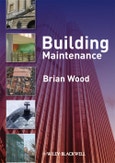Building Maintenance is a core text on the technical aspects of maintenance for undergraduate degree students on built environment courses, particularly building surveying and facilities management. It addresses the ‘who, what, where, when, how and why’ of maintenance activities and shows that maintenance should be considered seriously at the design stage. Extensive case studies illustrate what can go wrong, how to put matters right and how to get it right first time, next time.
A professional approach is required to building maintenance. By encouraging maintenance managers to stand back and take a strategic view of building maintenance alongside their day-to-day tasks, this book will help practitioners and students to achieve that.
Table of Contents
Foreword by Professor Jim Smith.Preface.
Acknowledgements.
1 Introduction.
Arrangement of this book.
Problems.
Checklists.
Maintenance: what is it; what is it for?
Definitions.
Shortcomings of definitions.
Purposes of building maintenance.
Context of building maintenance.
Political.
Economic.
Social.
Technological.
Environmental.
Summary.
References.
2 Design temptations.
Design standards.
Design team.
Design quality.
Summary.
References.
3 Maintenance planning.
Strategy.
What, where, when, how, (and how often), who and why.
Why a maintenance plan?
What?
Where?
When?
How?
Who?
Communication.
Case study: estate strategy in a UK university.
Background.
Issues.
Proposal.
Progress.
Assessment.
Summary.
References.
4 The client.
The key decision maker.
Reminder: the client pays the bills.
Wants and needs.
How to determine and differentiate wants and needs.
Practical application: example scenario.
Seeking advice.
When to seek advice?
How often to seek advice.
How soon to seek advice.
From whom to seek advice.
Giving advice.
Taking advice.
Summary.
References.
Useful websites.
5 Expectations.
Functionality.
Standards.
Overproduction.
Transportation.
Waiting.
Inventory.
Motion.
Overprocessing.
Defects and rework.
Other ‘wastes’.
Customer service.
Needs of the future: looking ahead.
A worked example – developing a checklist related to expectations.
Case study: maintenance delivery in a UK university.
Organisational context.
Priorities.
Monitoring and reporting.
Reflection.
Summary.
References.
Websites.
6 Day-to-day prioritisation.
Basics.
Getting by.
Putting off.
Maintenance and building inheritance.
Heritage.
The helpdesk.
Today’s needs.
Tomorrow.
Possible future scenarios.
Major works.
Minor works.
The Intermediate form.
Capital projects.
Revenue works.
Capitalised repairs.
Planned maintenance.
Response maintenance.
Checklist application.
Budgets, costs and contracts.
Contracts.
Procurement.
Decision making and recording.
Summary.
References.
7 Deterioration.
Weather and climate.
Processes.
Rain and snow.
Damp.
Wind.
Sun/ultraviolet light.
Temperature changes.
Durability.
Decay.
Wear and tear.
Projecting from past performance.
Data vs. information.
Limitations.
Functional obsolescence.
Case study: a local authority.
Background.
Issues.
Action.
Findings.
Reflection.
Summary.
References.
8 Building defects and avoidance.
Avoidance of defects.
Defects at the inception/pre-design stage.
Defects at the design stage.
Defects occurring during the construction stage.
Defects while the building is in occupation.
How to avoid defects.
‘Zero defects’.
Repair/replace decisions.
Specifications.
Summary.
References.
Useful websites.
9 Organisingmaintenance works.
Organisation.
Direct labour.
Specialist contractors.
General contractors.
Selecting contractors.
Procurement.
Prices and pricing.
Schedules of rates.
Tenders and tendering.
Contracts.
Service level agreements.
Case study: innovative building maintenance in a supermarket chain
Background.
Context.
Issues.
Findings.
Wider application.
Statutory requirements.
Development control: town and country planning.
Building control: Building Regulations.
Health and safety: Construction Design and Management Regulations.
Work in progress.
Supervision.
Inspection.
Payments.
Feedback.
Summary.
References.
10 Defect recognition and rectification: General.
Inspection.
Why?
How?
When?
Where?
Who should inspect?
What is to be done?
Recognition.
Recording.
Reporting.
Recognising, recording and reporting condition.
Extent.
Priority.
Rectification.
Defect rectification specifications.
Execution.
Follow-up.
Checklist: defect recognition and rectification.
Summary.
References.
11 Defect recognition and rectification: Foundations, basements and external works.
Outline: general arrangement.
Symptoms.
Possible causes.
Rectification.
Avoidance.
Foundations.
Cracks.
Ground conditions.
Underpinning.
Avoidance of problems in future.
Basements and cellars.
Water table.
Underground streams.
Cracked pipes and drains.
Tree roots.
Ventilation.
Sloping sites.
External works.
Freestanding walls.
Retaining walls.
Fences.
Paths.
Steps and ramps.
Parking.
Soft landscaping.
Common areas generally.
Summary.
References.
Useful websites.
12 Defect recognition and rectification: External walls, doors and windows.
External walls and frames.
Symptoms and possible causes.
Rectification work.
Concrete.
Claddings.
Windows and external doors.
Swelling and sticking.
Shrinkage and gaps.
Distortion.
Weathering and detailing.
Metal windows.
Bay windows.
Doors.
Glass and glazing.
Double and triple glazing; replacement doors and windows; PVCu.
Cills, heads, reveals and canopies.
Decorations.
Summary.
References.
13 Defect recognition and rectification: Chimneys, roofs and roofspaces, rainwater disposal.
Chimneys.
Pitched roofs.
Slates.
Clay tiles.
Concrete tiles.
Asbestos–cement slates and sheets.
Fibre–cement.
Sheet metal roofs.
Other roofing materials.
Roof forms and related details.
Valleys.
Eaves.
Dormer windows and other penetrations.
Steps – flashings.
Gables.
Attics and roofspaces.
Pitched roof structures.
Flat roofs.
Lead.
Felt.
Asphalt.
Insulation.
Protection.
Green roofs.
Rainwater disposal.
Summary.
References.
Helpful website.
14 Defect recognition and rectification: Floors, stairs and internal walls.
Ground floors.
Floor finishes.
Intermediate floors.
Stairs.
Handrails and balustrading.
Means of escape; protected routes.
Internal walls and finishes.
Summary.
References.
15 Defect recognition and rectification: Building services.
Plumbing: water, waste and soil.
Gas.
Gas usage.
Electrical and communication systems.
Heating, ventilation and air-conditioning.
Fire, security and other specialist services.
Security.
Summary.
References.
16 Upgrading and improvement.
Changing standards.
Incremental change.
Exponential change.
Step change.
Local or international standards.
What do we want?
Similar organisations.
How to decide?
How far to go?
Move or improve?
Mini case study.
Checklist.
Summary.
References.
17 The rehabilitation process.
Preparation.
Briefing.
Time: the essence.
Place.
Specifications.
Decanting.
Work in progress.
Preparing to move back.
Check.
Summary.
References.
18 New life in the building.
How was it for you?
The learning organisation.
Techniques and timings.
Periodic overview.
Annual review.
Formal feedback.
Post-occupancy evaluation (POE).
Pros and cons: why POE?
Who should do POE?
Monitoring and refreshing.
Documentation.
Refreshing the building.
Refreshing the organisation and staff.
Time and tide.
Checklist.
Summary.
References.
Index.








